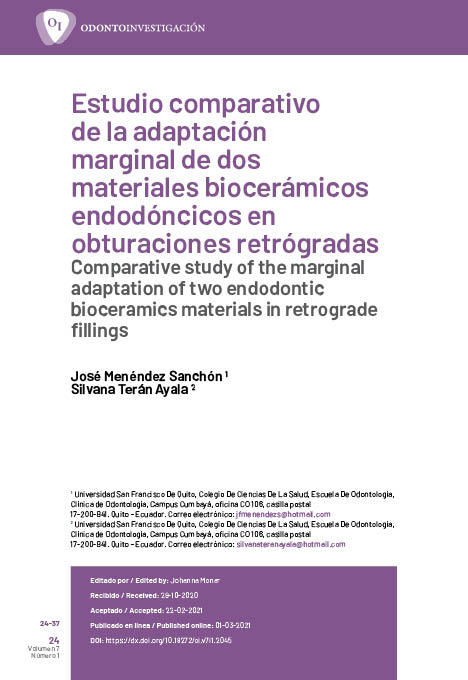Español
Main Article Content
Abstract
The aim of this study was to compare marginal adaptation of Endosequence Root Repair Material (ERRM) and Bio-C Repair, as root-end filling materials. Twenty extracted, single-rooted teeth were standardized to 15 millimeters. The remaining roots were prepared and subsequently, they were filled using the continuous wave technique. Then, the apical 3 mm of the root was sectioned and root-end preparation was done with ultrasonic tips. Samples were randomly allocated in two groups: Group A, in which root-end cavities were filled with ERRM paste; and Group B, in which Bio-C Repair was used for root-end filling. Scanning electron microscope images at different magnifications were used in order to measure the gaps between both retrofilling materials and dentin walls. Results showed that ERRM paste showed a mean gap of 6.43 μm, while for Bio-C Repair, the mean gap was 7.5 μm. Statistical analysis revealed that there were no significant differences between the two groups. In conclusion, Endosequence Root Repair Material paste and Bio-C Repair have similar marginal adaptation when used as root-end fillings.
Article Details
References
Benetti, F., Queiroz, Í. O. de A., Cosme-Silva, L., Conti, L. C., Oliveira, S. H. P. de, & Cintra, L. T. A. (2019). Cytotoxicity, Biocompatibility and Biomineralization of a New Ready-for-Use Bioceramic Repair Material. Brazilian Dental Journal, 30(4), 325-332.
Canalda Sahli, C., & Aguade, E. B. (2019). Endodoncia: Técnicas Clínicas Y Bases Científicas. Elsevier Health Sciences.
Jung, J., Kim, S., Kim, E., & Shin, S.-J. (2020). Volume of Voids in Retrograde Filling: Comparison between Calcium Silicate Cement Alone and Combined with a Calcium Silicate-based Sealer. Journal of Endodontics, 46(1), 97-102.
Kohli, M. R., Yamaguchi, M., Setzer, F. C., & Karabucak, B. (2015). Spectrophotometric Analysis of Coronal Tooth Discoloration Induced by Various Bioceramic Cements and Other Endodontic Materials. Journal of Endodontics, 41(11), 1862-1866.
López-García, S., Lozano, A., García-Bernal, D., Forner, L., Llena, C., Guerrero-Gironés, J., Moraleda, J. M., Murcia, L., & Rodríguez-Lozano, F. J. (2019). Biological Effects of New Hydraulic Materials on Human Periodontal Ligament Stem Cells. Journal of Clinical Medicine, 8(8), 1216.
Nagesh, B., Jeevani, E., Sujana, V., Damaraju, B., Sreeha, K., & Ramesh, P. (2016). Scanning electron microscopy (SEM) evaluation of sealing ability of MTA and EndoSequence as root-end filling materials with chitosan and carboxymethyl chitosan (CMC) as retrograde smear layer removing agents. Journal of Conservative Dentistry, 19(2), 143.
Nair, U., Ghattas, S., Saber, M., Natera, M., Walker, C., & Pileggi, R. (2011). A comparative evaluation of the sealing ability of 2 root-end filling materials: An in vitro leakage study using Enterococcus faecalis. Oral Surgery, Oral Medicine, Oral Pathology, Oral Radiology, and Endodontology, 112(2), e74-e77.
Rifaey, H. S., Villa, M., Zhu, Q., Wang, Y.-H., Safavi, K., & Chen, I.-P. (2016). Comparison of the Osteogenic Potential of Mineral Trioxide Aggregate and Endosequence Root Repair Material in a 3-dimensional Culture System. Journal of Endodontics, 42(5), 760-765.
Shinbori, N., Grama, A. M., Patel, Y., Woodmansey, K., & He, J. (2015). Clinical Outcome of Endodontic Microsurgery That Uses EndoSequence BC Root Repair Material as the Root-end Filling Material. Journal of Endodontics, 41(5), 607-612.
Shokouhinejad, N., Nekoofar, M. H., Ashoftehyazdi, K., Zahraee, S., & Khoshkhounejad, M. (2014). Marginal adaptation of new bioceramic materials and mineral trioxide aggregate: A scanning electron microscopy study. Iranian Endodontic Journal, 9(2), 144-148.

